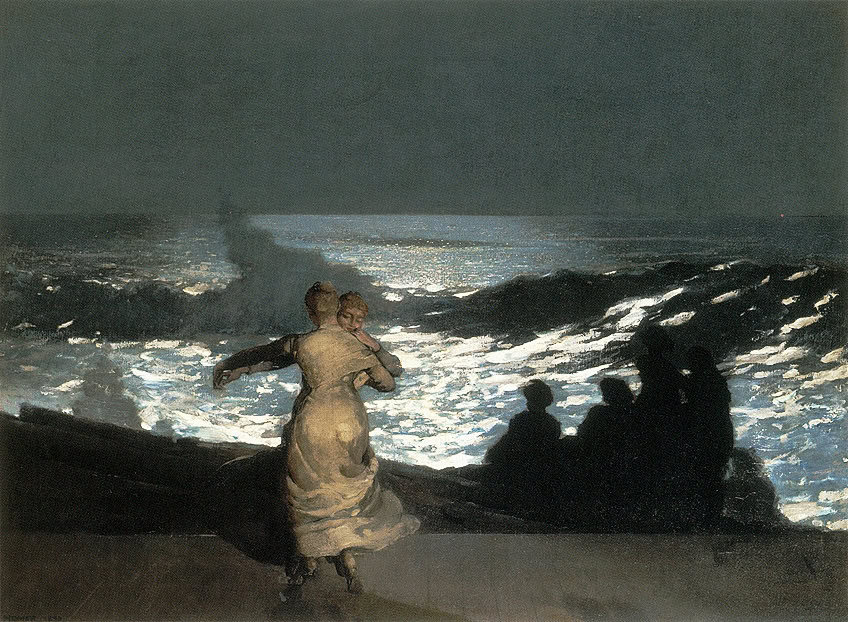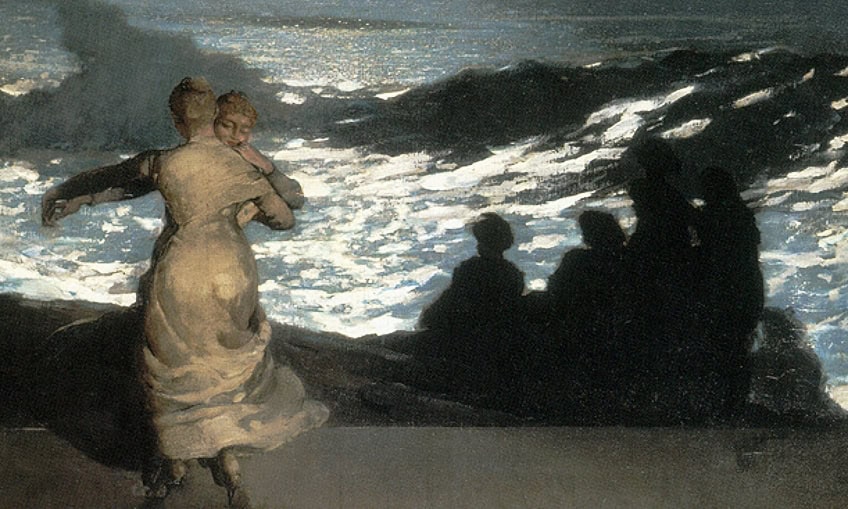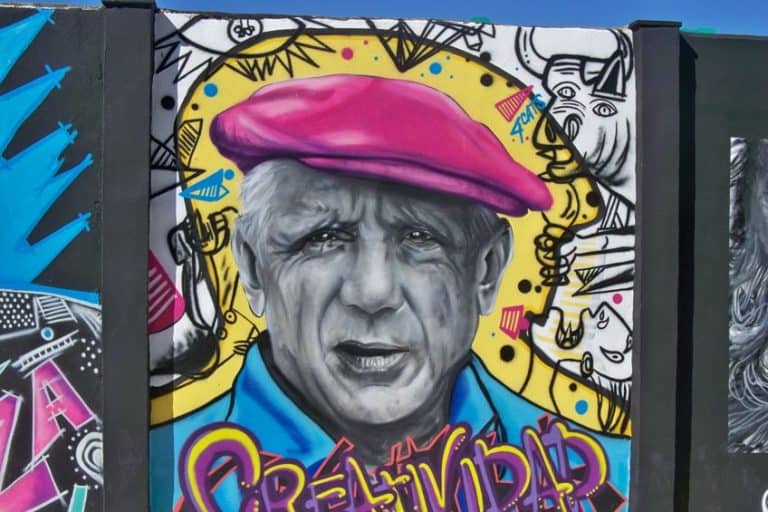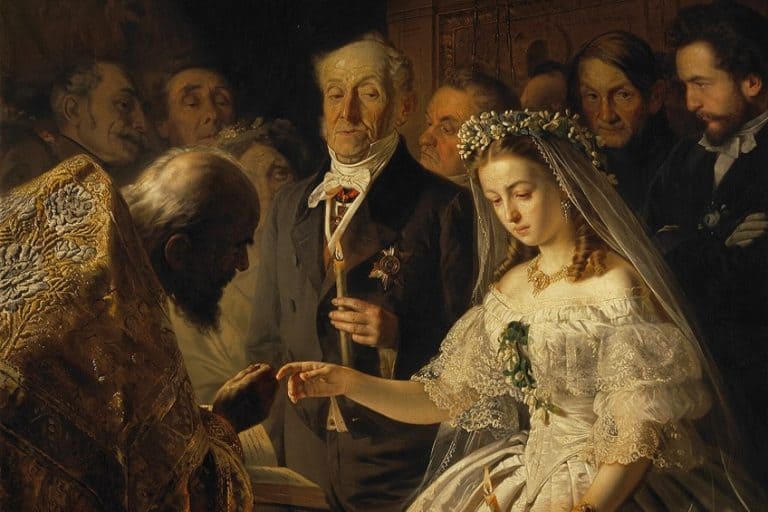“Summer Night” by Winslow Homer – Nocturnal Bliss
Summer Night, painted by Winslow Homer in 1890, is a masterful representation of American Realism, capturing the tranquility and subtle drama of a summer evening by the sea. Homer, known for his evocative depictions of nature and rural life, skillfully portrays two women dancing on the shore, their movements illuminated by the moonlight reflecting on the water. This painting stands out not only for its technical excellence but also for its exploration of light and shadow, creating a sense of intimacy and mystery. Summer Night exemplifies Homer’s ability to convey complex emotions and the beauty of the American landscape, making it a significant work in his illustrious career.
Key Takeaways
- Summer Night by Winslow Homer is a notable oil painting from 1890.
- The painting blends Realism with Symbolism to create a captivating nocturne.
- Its initial mixed reception has evolved into widespread admiration and acclaim.
Artistic Context and Historical Significance
| Artist | Winslow Homer (1836 – 1910) |
|---|---|
| Date Created | 1890 |
| Medium | Oil on canvas |
| Genre | Landscape |
| Period/Movement | American Realism |
| Dimensions (cm) | 76.5 × 102 |
| Series/Versions | Single version |
| Where Is It Housed? | Musée d’Orsay, Paris, France. Currently on loan to the Harvard Art Museums |
| What It Is Worth | Not publicly auctioned; significant cultural and historical value |
In 1890, Winslow Homer painted Summer Night, a remarkable oil on canvas that captivates viewers with its atmospheric depth. This nocturne scene places two women dancing gracefully by the shore under a moonlit sky, while shadows obscure other figures in the background. The painting’s ability to evoke mood rather than narrate an event positions Homer not just as a Realist but as an artist exploring Symbolism. Summer Night showcases Homer’s talent in blending meticulous realism with a mysterious, almost enigmatic quality. Painted at Prouts Neck, Maine, the piece has been celebrated as one of the best nocturnes in American art.

Its reception at Reichard’s Gallery in New York in 1891 was generally positive, though the work did face mixed reviews initially. Despite this, the painting’s allure has endured, making it a staple in discussions of 19th-century American art. Today, Summer Night continues to draw interest and admiration, currently on loan to the Harvard Art Museums from the Musée d’Orsay in Paris. Its surreal, enchanting representation of a moonlit night by the sea invites viewers to ponder the emotions and stories behind the figures.
This blend of technical skill and evocative imagery cements its place in the legacy of both Winslow Homer and American art.
Winslow Homer’s Career and Achievements
Winslow Homer began his career as a graphic reporter during the American Civil War. Notable works from this period include Home, Sweet Home, and Prisoners from the Front. By the late 1860s, Homer focused more on painting, exploring themes of nature and daily life.

The 1870s saw him experiment with watercolors, gaining significant recognition. His style evolved to capture the American spirit and landscapes, with a particular emphasis on the sea. His talent earned him accolades and solidified his position as one of the foremost American artists of his time.
Influence of 1890’s Art Scene on Summer Night
The 1890s were characterized by artistic innovation and a blend of various styles. Symbolism and Realism were particularly influential, and Homer skillfully integrated these into his work. Summer Night reflects this duality; while it portrays a realistic setting, it also evokes an enigmatic, symbolic mood. The backdrop of dancing figures by a moonlit sea captures more than just an event; it highlights the era’s fascination with exploring deeper, often mystical, themes.
The Exposition Universelle in Paris also played a role in shaping the art trends Homer was attuned to, further enriching his approach.
Exhibition History and Reception
When Summer Night debuted at Reichard’s Gallery in New York in 1891, it received mixed reviews. Some praised its innovative composition, while others were unsure about its symbolic elements. It did not sell immediately, and shortly after, Homer offered it to Potter Palmer, a Chicago collector.

The painting later became part of the prestigious collection at the Musée d’Orsay in Paris. Today, it continues to be celebrated as a quintessential example of Homer’s mastery and his ability to weave complex emotions and symbolism into his work.
The painting’s travels from New York to Boston, and eventually Paris, underscore its lasting significance in the art world.
Technical Aspects and Style
Winslow Homer’s Summer Night showcases his skillful use of light, color, and symbolism, blending realism with a sense of mystery. Painted in 1890, this oil painting stands out for its nocturnal setting and evocative mood.
Composition and Use of Light
Homer’s composition in Summer Night reveals a thoughtful arrangement where two women dance on a moonlit shore. This scene is balanced with a group watching from the shadows. Light plays a central role, with the moonlight casting a soft glow across the figures and creating distinct areas of light and shadow. The reflection of the moon on the water adds depth, while the contrast between illuminated and dark areas enhances the painting’s mysterious atmosphere.

Color Palette and Brushwork
The color palette is dominated by cool tones—deep blues and muted grays—capturing the essence of a summer night. The moonlight introduces subtle variations in these colors, creating a serene, almost dream-like quality. Homer’s brushwork varies from smooth, delicate strokes to more textured areas, which adds to the painting’s realism.
The detailed rendering of the figures contrasts with the more free-form treatment of the background, emphasizing the vibrancy and movement of the dancing women.
Symbolism in Summer Night
Symbolism in Summer Night is subtle yet impactful. The dancing women may symbolize freedom or joy, while their interaction with the moonlit sea conveys a sense of connection with nature. The shadows in the painting add an element of enigma, possibly representing the unknown or unseen aspects of life. Such symbolic layers encourage viewers to interpret the scene in multiple ways, making Summer Night a rich subject for analysis and discussion.

Themes and Interpretations
Winslow Homer’s Summer Night explores the interplay of women, nature, and symbolic elements through his evocative depiction. The painting focuses on the interaction between humans and their environment, capturing a mood that transcends the scene.
Portrayal of Women and Nature
In Summer Night, two women dance on the moonlit shore. Their movements are graceful and fluid, suggesting a deep connection with nature. The women’s clothing and flowing hair mirror the rhythmic waves. Their silhouettes are emphasized against the dark sea and sky, creating a sense of mystery.
The artwork highlights the harmony between humanity and the natural world. Homer’s choice to depict women signifies a gentle, nurturing presence. This portrayal can evoke thoughts on the feminine relationship with nature, symbolizing both beauty and strength.
Ocean and Shore as Symbolic Elements
The ocean and shore play key symbolic roles in the painting. The waves reflect the moonlight, creating a serene yet dynamic atmosphere. The endless horizon speaks to infinity and the unknown, inviting viewers to ponder the vastness of nature.
Homer uses the ocean to symbolize both challenge and inspiration.
The shore represents a boundary, a place where different worlds—land and sea—meet. This setting underscores themes of transition and the blending of distinct elements, paralleling the blend of realism and symbolism in the painting.
Interaction and Movement
Movement is central to Summer Night. The dancing women are not just moving; they are interacting intimately with their surroundings. The sway of their bodies echoes the gentle waves, creating a visual rhythm. Other figures in the background add depth and context. They observe from a distance, adding a layer of contemplation to the scene.
This interaction between the main figures and the background elements helps to weave a narrative of connection and observation. Homer’s use of movement in the composition captures the transient beauty of the moment, emphasizing the fleeting interaction between humans and nature. It invites viewers to reflect on the transient nature of life and the enduring presence of nature.
Cultural and Artistic Legacy
Summer Night by Winslow Homer has had a lasting impact on both American and international art. It is housed in the Musée d’Orsay in Paris and has influenced artists worldwide. This section explores its artistic influence, related works, and how the painting is preserved for public access.
Influence on American and International Art
Winslow Homer’s Summer Night revolutionized American seascape painting. Its composition and mood captured the mysterious nature of nocturnal landscapes. This work influenced both American and European artists by blending Realism with Symbolism. It was presented at the 1900 World Exhibition, which strengthened its international acclaim. From the United States to France, Homer’s techniques and themes have inspired generations of artists to explore similar nighttime scenes, reinforcing the painting’s place in art history.
Other Works Related to Summer Night
Homer’s other seascapes and nocturnes often mirror the mood and style of Summer Night. Paintings such as Moonlight, Wood Island Light, and Eight Bells further exhibit his fascination with maritime subjects and the play of light. These related pieces continue to be popular and studied for their emotional depth and technical skill.
The motif of dancing figures near the sea, as seen in Summer Night, reappears in several other works, indicating Homer’s recurring interest in human interaction with natural surroundings.
Preservation and Public Access
Summer Night is preserved at the Musée d’Orsay, Accession Number RF 640. The museum ensures its protection and proper display, allowing public access to this iconic piece. The painting has also been loaned to institutions, such as Harvard Art Museums, enhancing its accessibility and audience reach. Digital platforms like Joconde, a French database, provide additional information and imagery, facilitating global access to Homer’s masterpiece. These efforts ensure that Summer Night continues to be appreciated by a diverse audience.

Winslow Homer’s Summer Night remains a timeless testament to the artist’s profound ability to capture the essence of a moment and evoke a deep emotional response. Through his meticulous attention to detail and masterful use of light and shadow, Homer transports viewers to a serene coastal scene, inviting them to experience the tranquility and subtle magic of a moonlit summer evening. This painting not only highlights Homer’s technical prowess but also his sensitivity to the natural world and human experience. Summer Night continues to resonate with audiences today, solidifying its place as a cherished masterpiece in American art.
Frequently Asked Questions
What Artistic Techniques Did Winslow Homer Employ in Summer Night?
Winslow Homer used oil on canvas to create Summer Night. He combined elements of Realism with touches of Symbolism. The moonlit night scene, featuring women dancing by the sea, is painted with great attention to light and shadow. His brushwork captures the movement and atmosphere, making the scene feel alive and dynamic.
What Themes Are Depicted in Summer Night by Winslow Homer?
Homer’s Summer Night explores themes of nature, mystery, and human interaction. The dancing women and the moonlit sea create a serene yet enigmatic mood. The painting captures a moment of leisure and celebration, contrasting the calm of the sea with the vibrant dance on the shore.
How Does Summer Night Compare to Other Seascapes by Winslow Homer?
Compared to other seascapes by Homer, Summer Night stands out for its nocturnal setting and symbolic elements. While many of his seascapes focus on daytime scenes and the power of nature, this painting introduces a more tranquil and mysterious atmosphere. It reflects his versatility in depicting different moods of the sea.
What Influence Did Summer Night Have on American Landscape Painting?
Summer Night is considered one of the best nocturnes in American art. Its innovative use of light and shadow influenced other artists in the American landscape tradition. The painting highlighted the potential of capturing night scenes, encouraging future artists to explore and expand upon this theme in their own work.
Isabella studied at the University of Cape Town in South Africa and graduated with a Bachelor of Arts majoring in English Literature & Language and Psychology. Throughout her undergraduate years, she took Art History as an additional subject and absolutely loved it. Building on from her art history knowledge that began in high school, art has always been a particular area of fascination for her. From learning about artworks previously unknown to her, or sharpening her existing understanding of specific works, the ability to continue learning within this interesting sphere excites her greatly.
Her focal points of interest in art history encompass profiling specific artists and art movements, as it is these areas where she is able to really dig deep into the rich narrative of the art world. Additionally, she particularly enjoys exploring the different artistic styles of the 20th century, as well as the important impact that female artists have had on the development of art history.
Learn more about Isabella Meyer and the Art in Context Team.
Cite this Article
Isabella, Meyer, ““Summer Night” by Winslow Homer – Nocturnal Bliss.” Art in Context. June 24, 2024. URL: https://artincontext.org/summer-night-by-winslow-homer/
Meyer, I. (2024, 24 June). “Summer Night” by Winslow Homer – Nocturnal Bliss. Art in Context. https://artincontext.org/summer-night-by-winslow-homer/
Meyer, Isabella. ““Summer Night” by Winslow Homer – Nocturnal Bliss.” Art in Context, June 24, 2024. https://artincontext.org/summer-night-by-winslow-homer/.











